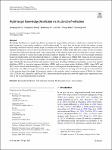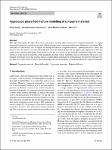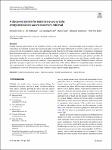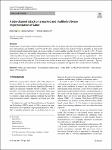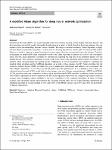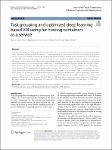Search
Author
- Jorgensen, Ed (3)
- McFadyen, Ron (3)
- Nora, El-Rashidy (3)
- Christian, Homeyer (2)
- next >
Subject
- programming (10)
- Open Access (8)
- Java (7)
- Programming (7)
- next >
Date issued
- 2020 - 2025 (293)
- 2010 - 2019 (39)
- 2000 - 2009 (2)
- 1999 - 1999 (1)
Has File(s)
- true (335)
Search Results
Knowledge distillation is a simple yet effective technique for deep model compression, which aims to transfer the knowledge learned by a large teacher model to a small student model. To mimic how the teacher teaches the student, existing knowledge distillation methods mainly adapt an unidirectional knowledge transfer, where the knowledge extracted from different intermedicate layers of the teacher model is used to guide the student model. However, it turns out that the students can learn more effectively through multi-stage learning with a self-reflection in the real-world education scenario, which is nevertheless ignored by current knowledge distillation methods. Inspired by this, we devise a new knowledge distillation framework entitled multi-target knowledge distillation via stud... |
This paper investigates the effect of moisture content upon the degradation behaviour of composite materials. A coupled phase field framework considering moisture diffusion, hygroscopic expansion, and fracture behaviour is developed. This multi-physics framework is used to explore the damage evolution of composite materials, spanning the micro-, meso- and macro-scales. The micro-scale unit-cell model shows how the mismatch between the hygroscopic expansion of fibre and matrix leads to interface debonding. From the meso-scale ply-level model, we learn that the distribution of fibres has a minor influence on the material properties, while increasing moisture content facilitates interface debonding. The macro-scale laminate-level model shows that moisture induces a higher degree of dam... |
Bayesian approaches to legal reasoning propose causal models of the relation between evidence, the credibility of evidence, and ultimate hypotheses, or verdicts. They assume that legal reasoning is the process whereby one infers the posterior probability of a verdict based on observed evidence, or facts. In practice, legal reasoning does not operate quite that way. Legal reasoning is also an attempt at inferring applicable rules derived from legal precedents or statutes based on the facts at hand. To make such an inference, legal reasoning follows syllogistic logic and first order transitivity. |
Based on the existing plant layout and process flow, a simulation analysis was conducted using the Plant Simulation platform with the utilization efficiency of each station and production capacity of the dismantling system as indicators. A problem with long-term suspension in the disassembly process was determined. Based on the two optimization directions of increasing material transportation equipment and expanding the buffer capacity, a cost-oriented optimization model is established. A genetic algorithm and model simulation were used to solve the model. An optimization scheme that satisfies the production needs and has the lowest cost is proposed. The results show that the optimized dismantling system solves the suspended work problem at the dismantling station and a significant ... |
Parametric timed automata (PTA) have been introduced by Alur, Henzinger, and Vardi as an extension of timed automata in which clocks can be compared against parameters. The reachability problem asks for the existence of an assignment of the parameters to the non-negative integers such that reachability holds in the underlying timed automaton. The reachability problem for PTA is long known to be undecidable, already over three parametric clocks. A few years ago, Bundala and Ouaknine proved that for PTA over two parametric clocks and one parameter the reachability problem is decidable and also showed a lower bound for the complexity class PSPACENEXP. |
Simulation platforms facilitate the development of emerging Cyber-Physical Systems (CPS) like self-driving cars (SDC) because they are more efficient and less dangerous than field operational test cases. Despite this, thoroughly testing SDCs in simulated environments remains challenging because SDCs must be tested in a sheer amount of long-running test cases. Past results on software testing optimization have shown that not all the test cases contribute equally to establishing confidence in test subjects’ quality and reliability, and the execution of “safe and uninformative” test cases can be skipped to reduce testing effort. However, this problem is only partially addressed in the context of SDC simulation platforms. In this paper, we investigate test selection strategies to increa... |
Finding relevant publications in the scientific domain can be quite tedious: Accessing large-scale document collections often means to formulate an initial keyword-based query followed by many refinements to retrieve a sufficiently complete, yet manageable set of documents to satisfy one’s information need. Since keyword-based search limits researchers to formulating their information needs as a set of unconnected keywords, retrieval systems try to guess each user’s intent. In contrast, distilling short narratives of the searchers’ information needs into simple, yet precise entity-interaction graph patterns provides all information needed for a precise search. |
In this paper, we show that a software implementation of IND-CCA-secure Saber key encapsulation mechanism protected by first-order masking and shuffling can be broken by deep learning-based power analysis. Using an ensemble of deep neural networks trained at the profiling stage, we can recover the session key and the secret key from 257×N and 24×257×N traces, respectively, where N is the number of repetitions of the same easurement. The value of N depends on the implementation of the algorithm, the type of device under attack, environmental factors, acquisition noise, etc.; in our experiments N=10 is sufficient for a successful attack. The neural networks are trained on a combination of 80% of traces from the profiling device with a known shuffling order and 20% of traces from the d... |
Deep Neural Networks (DNNs) are widely regarded as the most effective learning tool for dealing with large datasets, and they have been successfully used in thousands of applications in a variety of fields. Based on these large datasets, they are trained to learn the relationships between various variables. The adaptive moment estimation (Adam) algorithm, a highly efficient adaptive optimization algorithm, is widely used as a learning algorithm in various fields for training DNN models. However, it needs to improve its generalization performance, especially when training with large-scale datasets. Therefore, in this paper, we propose HN Adam, a modified version of the Adam Algorithm, to improve its accuracy and convergence speed. The HN_Adam algorithm is modified by automatically ad... |
Containers as a service (CaaS) are a kind of services that permits the organization to handle the containers more effectively. Containers are lightweight, require less computing resources, portable, and facilitate better support for microservices. In the CaaS model, containers are deployed in virtual machines, and the virtual machine runs on the physical machine. The objective of this paper is to estimate the resource required by a VM to execute a number of containers. VM sizing is a directorial process where the system administrators have to optimize the allocated resources within the permitted virtualized space. In this work, the VM sizing is carried out using the Deep Convolutional Long Short Term Memory Network (Deep-ConvLSTM), where the weights are updated by Fractional Pelican... |

